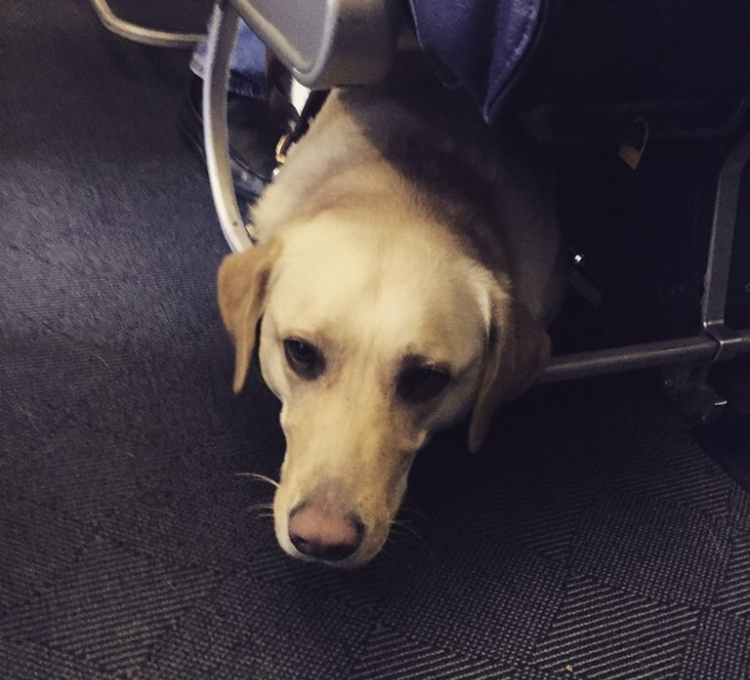Making sense of the Department of Transportation’s proposed changes to the definition of service animals
By Albert J. Rizzi, M.Ed.
UPDATE: After holding Public Hearings on travel with service animals, the DOT announced it has amended the Air Carrier Access Act (ACAA) to define a “service animal as “a dog that is individually trained to do work or perform tasks for the benefit of a person with a disability”. This amendment puts the DOT’s definition of a service animal in alignment with the definition as outlined in the Americans with Disabilities Act (ADA). People wanting to travel with their family pet or some other exotic creatures to avoid costs have been grounded and are no longer cleared for take-off. For more details on this announcement, click on this link: View the US Department of transportation Announcement
There now seems to be a light at the end of this proverbial tunnel for those of us traveling with legitimately trained service animals. The Department of Transportation (DOT) has proposed amendments to the Air Carrier Access Act (ACAA) on the transportation of service animals by air.
This newly proposed rule aligns with the definition of service animals as defined by the Department of Justice (DOJ) and the Americans with Disability Act (ADA). The proposed amendments are intended to ensure that the air transportation system in the United States is safe for the traveling public and accessible to individuals with disabilities. Specifically, the DOT proposes to change the definition of service animal, under its ACAA regulations in 14 CFR Part 382, as “a dog that is individually trained to do work or perform tasks for the benefit of a qualified individual with a disability, including a physical, sensory, psychiatric, intellectual, or other mental disability.”
Recently, a passenger interrupted normal operations on a JetBlue flight out of Austin, Texas because he was traveling with his pet possum. It wasn’t enough that he tried to bring the animal aboard but when questioned by airline personnel, he tried to claim the non-domesticated pet as a service animal. Sadly, this is only the most recent example of individuals attempting to get around regulations in place for people traveling with a pet, as opposed to a legitimate service animal trained to perform a specific task for those of us with a visible or even and invisible disability.
This man is not alone in his attempt to buck the system, though no one has attempted to pass off an actual buck as a service animal…at least not yet. However, people have tried to pass off pythons, turkeys, pigs, and llamas as “service animals,” just to name a few. This is ridiculous and unfair to the animal being misrepresented as a service animal, to those of us reliant on a service animal, to our fellow passengers, as well as all levels of airline staff both on the ground and in the cabin.
It’s difficult enough under ideal circumstances for someone with a legitimate need for a service animal to overcome ignorance in order to gain access to public accommodations. I can attest to this from personal experience. You may recall that I was involved in an incident that made national and international headlines a few years ago when I was removed from a flight along with my guide dog, Doxy.
When people attempt to pass off their pets as legitimate service animals to avoid the expense of transporting their pet, it makes it difficult for other passengers, regardless of whether they are reliant on the service animal or just sitting next to one. It’s also a problem for flight attendants and gate agents trying to weed out people attempting to pass of their pets as service animals.
Attempting to pass off untrained pets with dubious credentials as service or emotional support animals causes unacceptable health and safety issues including incidents of mauling, biting, urination, and defecation on airplanes. It also takes the animal out of its natural environment or comfort zone and puts the animal in question under unnecessary stress and danger. Not following this definition of a service animal only serves to trivialize legitimate service animals’ important role and purpose, mocking the purpose and real need for service animals.
At best, a person reading the headlines, not fully understanding the issue or regulations, will use such instances as a punch line for a cheap laugh. At worse, a person who lies about their pet being a properly trained service animal causes potential harm and discomfort amongst their fellow travelers, flight crews, and ground crews. They also contribute to potential flight delays or, in a few instances, the landing of planes prior to reaching their intended destinations.
Airlines have enough to manage when working to ensure the safety of 2.7 million passengers on 44,000 flights every day. Do they really need to take time to determine which animal is a pet versus a legitimate service animal? My Blind Spot, in partnership with American Airlines, led a coalition of like-minded organizations endorsing the DOT’s alignment and redefining of legitimate service animals versus emotional support animals versus a family pet. It’s our hope that through education and advocacy, we can put this issue to rest once and for all and see that pets are contained properly and are transported in a manner that does not compromise the use of legitimate service animals.
